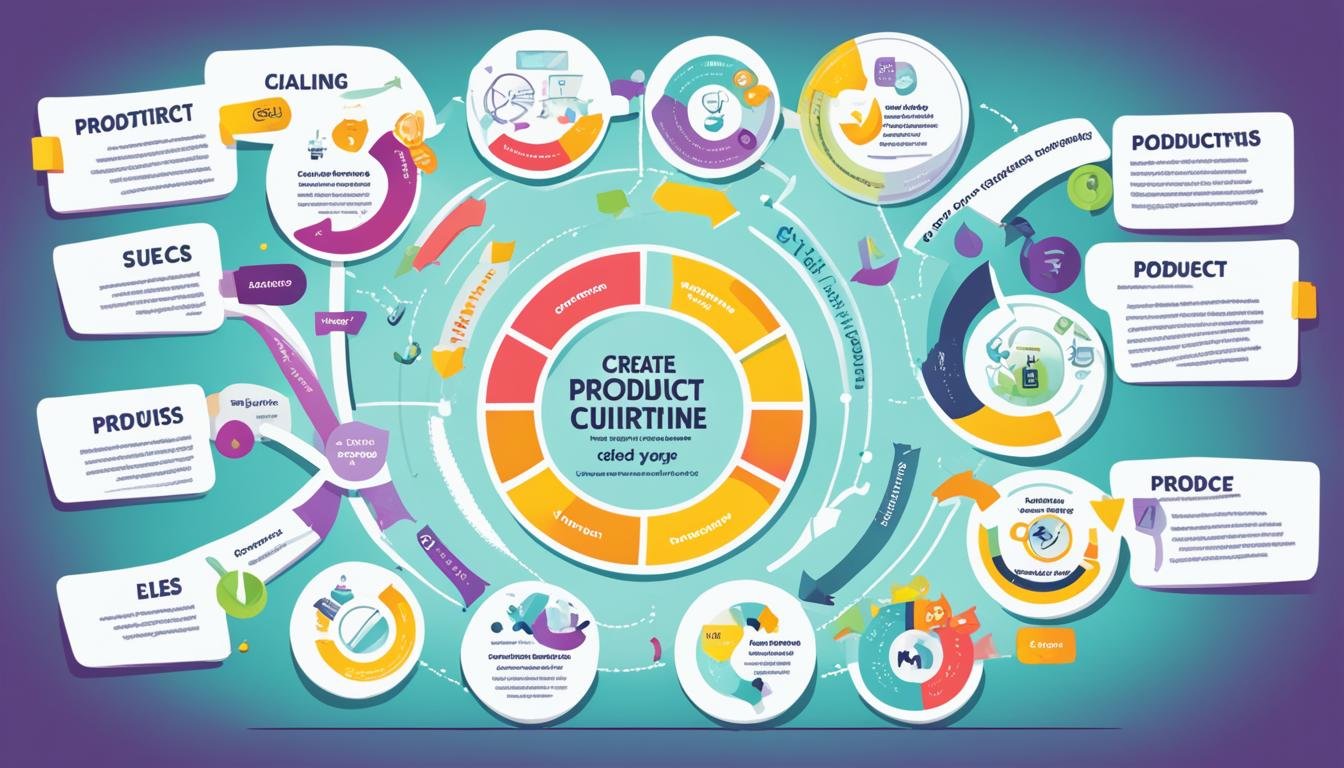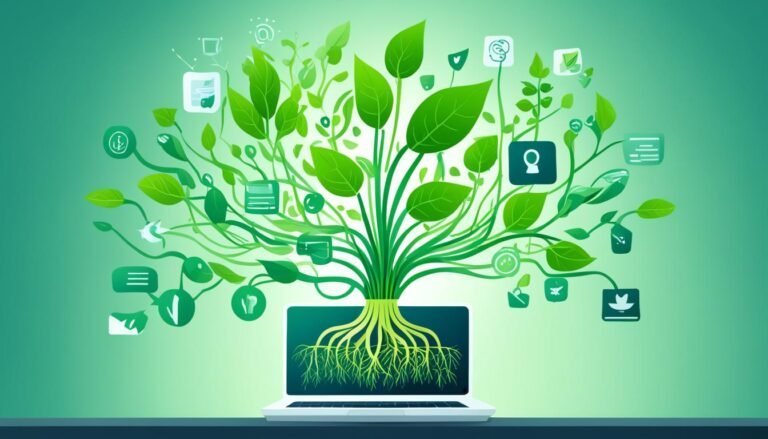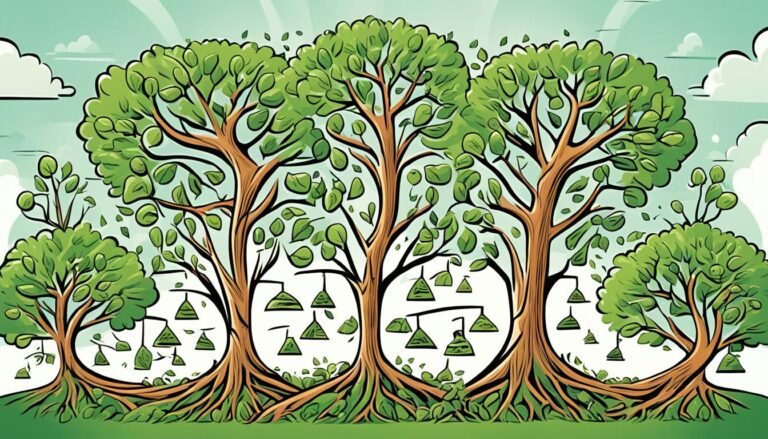The Product Life Cycle: Strategies for Each Stage
Did you know the product life cycle has helped companies save millions by improving their marketing and production plans? Knowing the different stages of the product life cycle is crucial. It helps extend your product’s life and boost profits. Each stage, from the start to the end, brings its own set of challenges and chances.
The introduction stage is tough, with high marketing costs and low sales. But, the maturity stage is usually the most profitable, with lower costs. Even big companies like Microsoft know when it’s time to move on, like ending Windows 8.1 in 2023. This shows the importance of being quick to adapt through the product life cycle.
Key Takeaways
- The product life cycle includes introduction, growth, maturity, and decline stages.
- Introduction strategies focus on establishing brand identity and consumer awareness despite high marketing costs.
- Growth strategies aim to boost profits through quality improvements and market expansion.
- Maturity stage is the most profitable, emphasizing market and product modifications for sustained demand.
- Decline strategies involve reducing costs and exploring new uses or exits for the product.
- Understanding and tailoring strategies for each stage increases product longevity and profitability.
Next, we’ll look into strategies for each stage of the product life cycle. These strategies will help make sure your product does well and lasts longer in the market.
Understanding the Product Life Cycle
The Product Life Cycle is key in product management. It guides strategies from the start to the end of a product’s life. Knowing each stage and its challenges helps product managers aim for success and a longer life for their products.
Definition and Importance
The Product Life Cycle is the journey a product takes from start to end. It has main stages: introduction, growth, maturity, and decline. Knowing these stages helps in making smart choices about marketing, sales, and new product ideas.
This cycle is crucial in product management. It impacts decisions on ads, prices, and growing the market. About 83% of companies start with product development, showing its big role. It also helps predict earnings and profits by comparing with similar products before.
Stages of the Product Life Cycle
The Product Life Cycle has several stages:
- Development: This is when a lot of research and development happens before the product is launched.
- Introduction: At this stage, companies spend about 30-35% of their budget as the product hits the market.
- Growth: Demand and sales go up, leading to lower costs and more profits.
- Product Maturity: Demand may stay steady with steady profits and lower costs. But, 80% of new products start to decline from growth to maturity each year.
- Decline: Sales and market share drop due to competition and market fullness. Only 10% of companies can extend their product’s life by going global.
Product managers use these stages to plan smartly. They know when to invest more and when to cut back. This ensures their products grow and stay strong over time.
Introduction Stage Strategies
The introduction stage is key for a product’s success. It lays the groundwork for what comes next. At this stage, strategies focus on building a brand, working with partners, and testing with consumers.
Businesses must decide between quick or slow strategies. This depends on their goals and the market they’re in.
Establishing Brand Identity
Creating a strong brand identity is vital during the launch. It means making a clear and strong value proposition. This sets the product apart from others.
High promotional efforts and ad spending are crucial. They make sure people know about the new product and what makes it special.
Connecting with Partners
Partnerships are key in introducing a product. Working with retailers, influencers, and other partners expands the product’s reach. Strong partnerships help with market entry and support the brand.
Setting Up Consumer Tests
Testing with consumers is vital to check if the product meets expectations. Through various tests, companies can learn what works and what doesn’t. This helps fix any issues before the big launch.
It also makes customers happier and more loyal to the brand.
Growth Stage Strategies
The growth stage is key, with fast Product Growth and a focus on Increasing Market Share. Companies need to use various strategies to make more profit and reach more people.
Improving Product Quality
Listening to customer feedback is vital here. As more people want the product, making it better can really help. It keeps the product competitive and meets what customers want, building loyalty and more sales.
Entering New Market Segments
Reaching new customers or areas is important for growing your market share. Doing thorough market research helps find where to grow and what customers need. Working with partners can make entering new markets easier and faster.
Increasing Distribution Channels
Having the product in more places is key to reaching more people. Growing both online and offline sales channels can really boost sales. This makes the product easier to find and use, helping it become more popular.
This stage requires careful planning, focusing on quality, reaching more people, and being easy to get. By using these strategies, companies can keep growing and stay ahead in a changing market.
Maturity Stage Strategies
In the maturity stage, businesses face both challenges and chances. They need to deal with Product Maturity and Market Saturation. To stay relevant and grow, companies must use smart strategies.
Market Modification
Changing the market is key to growth in the maturity stage. Companies need to look at their customers again. For example, Cheerios targeted aging baby boomers by showing how their cereal is heart-healthy.
This helps fight off sales drops and deal with a crowded market. The goal is to keep an eye on market trends and change your approach as needed.
Product Modification
Changing products is also crucial in the maturity stage. It means making current products better to fit what customers want and like. Chobani did this in 2015 by changing their yogurt containers and making their product better.
Changes like these can make a product more interesting and keep it fresh in a crowded market. It’s important to always be improving your products to keep customers interested in a competitive market.
The Product Life Cycle: Strategies for Each Stage
Each stage of the product life cycle has its own set of challenges and opportunities. Companies need a dynamic product strategy to stay ahead. This approach is key from the start to the end of a product’s life.
The product life cycle has four main stages: Introduction, Growth, Maturity, and Decline. Each stage needs its own strategy for success:
- Introduction Stage: Sales start to rise as people get to know the product. Companies should run promotional campaigns and build a strong brand.
- Growth Stage: As the brand gets more popular, focus on keeping customers loyal and reaching more people.
- Maturity Stage: Sales may slow down because the market is full. At this point, companies should innovate, make product changes, and keep customers.
- Decline Stage: Sales drop a lot. Companies might cut back on ads, harvest what they can, leave the market, or try to revive the product.
Every year, over 20,000 new products come out, like “100 calorie packs” and cereal bars. Some do well, others don’t. It all depends on the strategy used.
For example, Clear Pepsi didn’t last long, but Diet Coke by The Coca-Cola Company grew quickly after launch and is still popular. This shows how important a good strategy is.
It’s important to invest in new products for a long time, especially if they’re going into new markets. Looking at how a product compares to others helps improve marketing and quality.
Knowing about the product life cycle helps companies use their resources well, stay innovative, and keep up with competitors. This way, they can predict the future and stay relevant in the market.
In conclusion, having a specific strategy for each stage of the product life cycle is key to success. It helps companies grow and adapt, even when products start to decline.
Saturation Stage Tactics
When products reach the saturation stage, companies face the challenge of keeping up with growth. This is because competitors have also caught up. It’s important to have effective strategies to beat Product Saturation and stay relevant in the market.
Innovative Marketing Campaigns
Launching new marketing campaigns is a key strategy. These campaigns should make the product stand out. Using new marketing channels and listening to customer feedback can grab attention and increase engagement.
Companies like Apple and Nike are great at this. They keep coming up with unique marketing ideas, even when the market is full.
Niche Market Exploration
Looking into Niche Marketing can help businesses reach specific groups that others ignore. By finding these special areas, companies can offer solutions that fit exactly what these groups need. This not only keeps sales up but also builds a strong customer base.
Brands like Tesla have done well by focusing on eco-conscious consumers. They’ve found a niche and made products that appeal to those people.
Strategies for the Decline Stage
The decline stage of the product life cycle is tough. Sales and profits drop, making it crucial to make smart choices. Cost-cutting strategies are key to getting through this tough time.
Reducing Promotional Expenditure
Reducing promotional spending is a top strategy for product decline. Cutting back on ads and marketing helps when they don’t bring in much. By focusing on what works, companies can use their money better.
Harvesting or Exiting
Deciding to harvest or exit the market is another big choice. Harvesting means reducing investments but still selling to make profits. This way, companies can squeeze out the last bit of value from the product. On the other hand, exiting means stopping production to focus on new opportunities. It’s important to think carefully about what to do next.
Potential Product Revival
Even in decline, there’s hope for a comeback. Rebranding, repackaging, or tapping into new trends can help. Look at TextMagic turning to email marketing or Harry Potter’s success with merchandise. These moves show how adapting can breathe new life into a product.
In conclusion, overcoming the decline stage needs both cost-cutting and new ideas. By closely watching the market and being ready to change or revamp the product, companies can make it through this tough phase. This could even lead to a comeback.
Importance of Product Innovation
Product innovation is key to staying ahead in today’s fast-changing market. With new tech and changing what people want, products don’t last as long. Companies must keep improving to keep up.
This helps them stay in the game and keep their customers.
Adapting to Market Changes
Being able to change quickly is vital today. Companies that quickly update their products do well. For example, the phone and computer industries are always changing.
They need to keep making their products better to lead. Coca-Cola keeps coming up with new drinks to keep customers interested, even when tastes change.
Knowing how well the market accepts a product helps decide when to bring out new versions.
Continuous Improvement
Always looking to get better helps companies keep innovating. This way, they can keep their products fresh and interesting. Havaianas flip-flops, for instance, have become very popular by always improving and marketing well.
Having a plan for new products keeps cash flowing and helps with future profits.
By focusing on always getting better, companies can handle risks, adapt to changes, and stay competitive. This leads to growth, more innovation, and better profits over time. So, companies with a strong plan for new products can keep doing well and keep their customers happy.
Product Lifecycle Marketing
Product Lifecycle Marketing is key to keeping a product interesting as it goes through different stages. These stages include introduction, growth, maturity, saturation, decline, and revival. Using the right marketing mix and targeting strategies can greatly help a product succeed at each stage.
Effective Use of Marketing Mix
The Marketing Mix, which includes product, price, place, and promotion, is crucial at every life cycle stage. At the start, promotions, influencer marketing, and big media ads can make a product buzzworthy. Apple’s launch of the first iPhone in 2007 is a great example of this.
When a product is growing, improving its quality, offering great customer service, and expanding into new markets is important. Zara’s quick fashion model helped it grow steadily.
Segmentation and Targeting
Knowing how to segment the market helps in targeting better. In the maturity stage, adding new products, selling more together, and keeping customers coming back are key. Kellogg’s uses these tactics to stay on top.
When a product is getting saturated, new marketing ideas and reaching niche markets are essential. In the decline stage, managing costs and targeted promotions help keep profits up.
Adapting marketing to the product life cycle helps businesses stay competitive and build loyal customers. This leads to ongoing growth and profits.
Source Links
- Product life cycle strategies | nibusinessinfo.co.uk
- Product Life Cycle Explained: Stage and Examples
- Product Life Cycle Marketing Strategies for Each Stage of the Product
- What Are the 4 Stages of a Product Life Cycle | Mailchimp
- Marketing Strategies – Stages of Product Life Cycle
- What is a Product Life Cycle? (Definition, Stages and Examples)
- 4 Stages of the Product Life Cycle: Strategies for Success
- Product Life Cycle Strategies Guide: Strategy for Each Stage
- Growth Stage of Product Life Cycle: Things You Need to Know and Implement
- The 6 Stages of the Product Life Cycle [+Examples]
- 9.4 Marketing Strategies at Each Stage of the Product Life Cycle – Principles of Marketing | OpenStax
- How to Manage the Maturity Stage of Product Life Cycle
- Maturity Stage of Product Life Cycle: How to Sustain Growth
- 11.3 Managing New Products: The Product Life Cycle
- Reading: Stages of the Product Life Cycle
- Product life cycle stages and how to use them
- Product Life Cycle – Stages of the Product Life Cycle and Their Importance for Product Management – Copymate
- Decline Stage of Product Life Cycle: Overview and Strategies
- Product life cycle: stages and marketing strategies – Stockagile
- Product Life Cycle: Importance for Business | SafetyCulture
- Managing product life cycle as a way to increase your business’s long-term competitive advantage
- Product Life Cycle in Marketing: Essential Product Marketing Strategies







